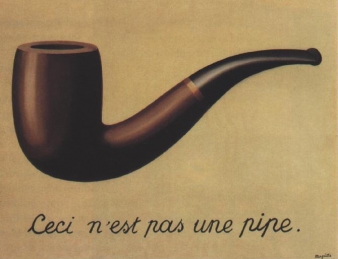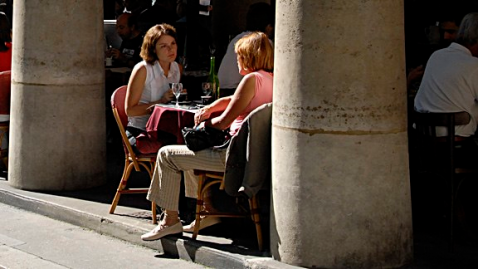We have often heard that architecture is, in part, a language. It's certainly true that most of us want our buildings to have meaning and relevance, to somehow reflect our values, to say something about us and our society, to have purpose beyond the pragmatic, to "stand for something".
These desires say a lot about what we expect from our buildings. In order for our built environment to meet these goals, designers need to be able to encode meaning into their creations, and then the inhabitants must to be able to extract that meaning. What I'm describing here - the mapping of meaning into the built environment, and then the subsequent reading of that map - is an act of communication. Communication is a transfer of information, and that transfer requires a medium of exchange. A meaningful and articulate architecture therefore requires a language.
What I'm describing here - the mapping of meaning into the built environment, and then the subsequent reading of that map - is an act of communication. Communication is a transfer of information, and that transfer requires a medium of exchange. A meaningful and articulate architecture therefore requires a language.
Style as a Language
In verbal languages, words are symbols - abstractions that represent some aspect of reality. Grouped together, words create phrases, sentences, paragraphs, chapters and stories - all intended to communicate an underlying meaning.
It's not a big leap for us to take, then, to identify the elements of architectural style as the vocabulary, syntax and grammar of an environmental language that allows the creators of our buildings to communicate with those who experience those buildings. As designers, we should be aware that our buildings will speak to people, whether we choose to actively recognize it or not. It's important that we take care to deliberately craft the underlying message, and make sure that the language we are employing to facilitate the communication of that message is up to the task.
A look at some relevant concepts related to linguistic and semantic theory can help provide a framework for understanding the nature of the relationship between the medium and the message of architecture.
Alfred Korzybski and the Map-Territory Relation
 figure 1. Alfred Korzybski
figure 1. Alfred Korzybski
Alfred Korzybski was a Polish-American philosopher, teacher, semanticist and scientist who died in 1950. Korzybski's life's work was focused on the role of language in human psychology, and culminated in the founding of a discipline he called General Semantics.
Korzybski's General Semantics offered a view that human knowledge is limited by two main factors: the structure of the human nervous system, and the structure of human languages. He maintained that people cannot experience the world directly, but only through their "abstractions" - nonverbal impressions derived from data detected and transmitted by the senses and the nervous system, and verbal indicators derived from language.
Korzybski cautioned that the structure of our languages determines in no small part the way we think. For example, he taught that certain uses of the verb "to be" were faulty in structure. To illustrate, consider a statement such as, "Joe is a fool" (said of a person named 'Joe' who has done something that we regard as foolish). According to Korzybski, one's assessment of Joe belongs to a higher order of abstraction than Joe himself. We find Joe not in the verbal domain, the world of words, but in the nonverbal domain. These two domains represent two different orders of abstraction. Korzybski' maintained that the correct approach is a denial of identity; in this example, to be continually aware that what we call Joe is an abstraction, and that abstraction ought not to be confused with the entity "Joe" himself.
Korzybski stressed that a key goal of his philosophy, and a key aspect of a healthy mind, was what he called "consciousness of abstracting". By this he meant the act of constantly reminding one's self that one's perception and awareness of reality are abstractions, and not to be confused with reality itself.
Here's a story about Alfred Korzybski that's amusing, and worth repeating because it's illustrative of some of these ideas: One day, Korzybski was giving a lecture to a group of students, and he suddenly interrupted the lesson in order to retrieve a packet of biscuits, wrapped in white paper, from his briefcase. He muttered that he just had to eat something, and he asked the students on the seats in the front row, if they would also like a biscuit. A few students took a biscuit. "Nice biscuit, don't you think", said Korzybski, while he took a second one. The students were chewing vigorously. After a while he tore the white paper from the biscuits, in order to reveal the original packaging. On it was a big picture of a dog's head and the words "Dog Cookies". The students looked at the package, and were shocked. Two of them wanted to throw up, put their hands in front of their mouths, and ran out of the lecture hall to the bathroom.
"You see, ladies and gentlemen", Korzybski remarked, "I have just demonstrated that people don't just eat food, but they also eat words, and that the taste of the former is often outdone by the taste of the latter."[1] It seems his prank aimed to illustrate how some human suffering originates from the confusion or conflation of linguistic representations of reality, and reality itself.
"The Map Is Not The Territory"
His most influential premise, this remark by Korzybski encapsulates his view that an abstraction derived from something, or a reaction to it, is not the thing itself. For example, the feeling of joy one feels upon looking at a beautiful flower is not the flower; a metaphorical representation of a concept is not the concept itself. A specific representation or reaction cannot capture all aspects of its source, and this inability to know all aspects of reality may limit an individual's understanding and cognitive abilities, unless the two are distinguished. Korzybski held that many people do often confuse "maps" with "territories".
Thus, the map-territory relationship is the relationship between higher-order abstractions, such as beliefs derived from input from our nervous systems, or the structure of our languages, and the underlying reality. Korzybski stressed that some maps, some abstract representations of reality, are better that others, and what distinguishes a better map from a poorer one is the degree to which they have a structural similarity to the underlying reality.
The Treachery of Images
The map/territory relation as a conceptual model has been important in many corners of culture and philosophy. Writers as diverse as Robert Anton Wilson, William S. Burroughs, and Buckminster Fuller have been influenced by this idea.
 figure 2. La trahison des images, René Magritte, 1928–29A classic example of map-territory relation graphically displayed comes from the
world of art. The Belgian
surrealist artist René Magritte illustrated the concept of perception always
interceding between reality and ourselves in a number of paintings including
this famous work entitled "The Treachery Of Images" [figure 2], which consists
of a drawing of a pipe with the caption in French, "This is not a pipe" - a statement which seems
false but is actually true. Of course, the painting is not a pipe, but rather
an image of a pipe. As Magritte himself commented: "The famous pipe. How
people reproached me for it! And yet, could you smoke my pipe? No, it’s just a
representation, is it not? So if I had written on my picture ‘This is a pipe,’
I’d have been lying!"[2]
figure 2. La trahison des images, René Magritte, 1928–29A classic example of map-territory relation graphically displayed comes from the
world of art. The Belgian
surrealist artist René Magritte illustrated the concept of perception always
interceding between reality and ourselves in a number of paintings including
this famous work entitled "The Treachery Of Images" [figure 2], which consists
of a drawing of a pipe with the caption in French, "This is not a pipe" - a statement which seems
false but is actually true. Of course, the painting is not a pipe, but rather
an image of a pipe. As Magritte himself commented: "The famous pipe. How
people reproached me for it! And yet, could you smoke my pipe? No, it’s just a
representation, is it not? So if I had written on my picture ‘This is a pipe,’
I’d have been lying!"[2]
Treachery indeed!
Style:Meaning = Map:Territory
An illuminating way to view the relationship between architectural style and the meaning of architecture is as a map-territory relationship. In the same way that the constructs of verbal languages serve as maps to guide us to an understanding of aspects of reality, of the world "as it is", so does the grammar of architectural style serve as the language with which we map meaning into our built environment.
When approaching the subject of style in architecture, it's important to carefully consider Korzybski's observation that good maps bear a close structural similarity with the underlying territory. As applied to architecture, this suggests that the selection and use of style should be carefully orchestrated so that the selected language (the map) bears a close structural similarity to the message that we want to convey (the territory).
We've all experienced buildings that just didn't feel right to us. Perhaps it was a feeling that a building didn't quite fit in its environment - a feeling that our experience of the place was inauthentic, or synthetic, that it lacked depth or relevance. Perhaps we had a vague feeling that the purpose of the building was somehow at odds with the way the building made us feel and react emotionally. Perhaps the building left us cold, unfulfilled, confused. I'd like to suggest that often the problem with these environments stems directly from the designer's inability or unwillingness to properly consider the relationship between the style map and the underlying territory of meaning. The only way we can experience the reality of meaning in our built environment is through the structure of style. Choose your languages with care, and use them thoughtfully.
We've all experienced buildings that just didn't feel right to us... often the problem with these environments stems directly from the designer's inability or unwillingness to properly consider the relationship between the style map and the underlying territory of meaning.
We believe these concepts are further foundation for a stance of style agnosticism - a reservation of belief in the righeousness or inferiority of particular styles of design (see my essay, "The Genealogy of Style" for further discussion). This is a point of view that regards style as a language, in precisely the same sense as English, or Japanese, Sanskrit or HTML. As languages, they are a higher order of abstraction than the underlying content. As such they are value neutral, and in some basic sense interchangeable.
The selection of an appropriate style for the task is of crucial importance, however. Just as Korzybski reminds us to make sure our maps have a structural similarity to the territory, so we must choose and tailor our language of style so that its structure is appropriate for the meaning we are trying to convey. To have too loose a fit between our style map and the underlying message is to risk faulty communication, and the potential of an inarticulate and unsatisfying architecture.
Wisdom Embedded Within Beauty
A perfect example of how the deep meaning of architecture can be mapped mapped by the language style can be seen through a biological metaphor. I'm grateful to my colleague Steve Mouzon for the following delightful insight. Mouzon is an architect from Miami, Florida, and one of the founders of the New Urban Guild. In his book, "The Original Green: Unlocking the Mystery of True Sustainability" (Guild Foundation Press, 2010), he identifies a similarity between the mechanism by which nature encodes meaning into the genetic structure, and the mechanism by which meaning in architecture is mapped stylistically.
Mouzon writes, "Nature has a better way of spreading great wisdom. The most complicated wisdom yet discovered by humanity is the human genome, which took legions of scientists many years to decode. Yet human genes are spread by billions of people with no genetic education and nothing but on-the-job training. How can this be?"
 figure 3. from Mouzon"Nature’s
way of spreading human genes begins with attraction of one person to another.
If they’re attracted enough to each other, they mate, they breed (not
necessarily in that order) and they pass down their genetic material. What is
the secret?"
figure 3. from Mouzon"Nature’s
way of spreading human genes begins with attraction of one person to another.
If they’re attracted enough to each other, they mate, they breed (not
necessarily in that order) and they pass down their genetic material. What is
the secret?"
"Look at the young woman in the image, having lunch on the streets of Paris.[figure 3.] Judging by appearances, one would have to say that she is quite likely to spread her genes because she is attractive. But she likely would tell you immediately, “there’s much more to me than just my appearance.”
 figure 4. The birds and the bees..."And
she would be correct. Nature, you see, embeds wisdom (the genetic code) in
beauty. People don’t have to know anything about the genetic code in order to
spread it... they simply have to be attracted to a person with whom they want
to spread it... and the code they are spreading is so much greater than the
attraction that led them to that person to begin with."[3]
figure 4. The birds and the bees..."And
she would be correct. Nature, you see, embeds wisdom (the genetic code) in
beauty. People don’t have to know anything about the genetic code in order to
spread it... they simply have to be attracted to a person with whom they want
to spread it... and the code they are spreading is so much greater than the
attraction that led them to that person to begin with."[3]
Think about that. Wisdom embedded within beauty. Of course, nature is full of examples of this phenomenon.
Mouzon continues, "Architecture once did something very similar. Someone might work for years to figure out the best possible eave for a region of the world, for example. They might do countless calculations of sun angles, storm winds, etc., and might do numerous experiments. But if they can then embed that wisdom in beauty by designing the eave in such a manner that the people of the region consider it to be beautiful, then nobody else needs to do the calculations, or the experiments, or show their work; they simply need to love the pattern." [3]
This is one of the most important and enduring virtues of traditions in architecture. This embedding of wisdom within beauty is a perfect example of meaning in architecture being directly mapped by the language of style. What a marvelous lesson to learn from the natural world!
Steps Towards an Articulate Architecture
How should we approach our work, then, if we're influenced by these ideas? I don't believe that it's enough for us simply to expertly craft buildings that observe the proper grammar and syntax of particular styles. Before the selection of a visual language, a style, we should begin our work with a deliberate process of message-crafting. We should consciously, actively guide our clients on a path of inquiry, exploring questions such as:
- "What kind of experience do we want our building to produce?"
- "What core values do we share and want to communicate to those that use our building?"
- "What key words exemplify how we live our lives?"
- "What wisdom do we want our building to convey?"
- 'What story do we want to tell?"
Before the selection of a visual language, we believe that we should begin our work with a deliberate process of message-crafting. We should consciously, actively guide our clients on a path of inquiry...
It's only after we craft a robust, authentic and engaging message that we can converge on the stylistic language that's appropriate to use as our medium of communication.
Experientially, we can only access the meaning of architecture through structure - the structure of style. Parsing the dialect of style can be a mesmerizing pursuit. Of course, some practitioners actually consider themselves to be "stylists", and have built careers around the deliberate and nuanced mastery of a particular language.
I understand the appeal of languages. Cultured persons around the world pride themselves in using their native verbal languages in a nuanced and beautiful way. Computer programmers find great satisfaction in constructing elegant assemblages of machine code. Poets labor long over the use of the language and revel in the pursuit of a perfect phrase, or words that make the perfect sound when uttered. So should architects rightfully find the examination and articulation of style a fulfilling pursuit.
But if our goal is an articulate architecture that has meaning to people, then it's particularly important that we not forget that style is a higher order of abstraction than the underlying meaning. It's a means to an end. I believe that a meaningful architecture must have a carefully crafted message, and that the selection of style should flow from the message we have crafted. As designers, we should be as concerned about what we are saying as we are about how we are saying it.
[1] R. Diekstra, Haarlemmer Dagblad, 1993, cited by L.
Derks & J. Hollander, Essenties van NLP (Utrecht: Servire, 1996), p. 58.
[2] Torczyner, Harry. Magritte: Ideas and Images. p. 71.
[3] Mouzon,
Stephen A. The Original Green:
Unlocking the Mystery of True Sustainability (Guild Foundation Press, 2010)
Add your comment.